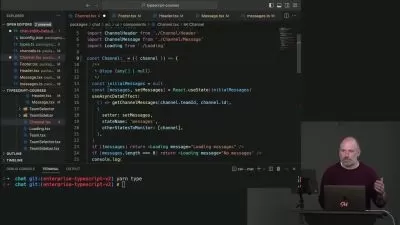TypeScript Design Patterns And SOLID Principles
Manik (Cloudaffle)
16:54:46
Description
Complete Guide to Gang Of Four Design Patterns, SOLID Principles and Object Oriented Programming Using TypeScript.
What You'll Learn?
- Master Gang of Four design patterns in TypeScript to write scalable and maintainable code for real-world applications.
- Gain in-depth understanding of SOLID principles to develop clean, modular, and robust TypeScript code for better software design.
- Creational Design Patterns including Singleton, Factory Method, Abstract Factory, Builder, and Prototype to effectively manage object creation in TypeScript.
- Gain expertise in Structural Design Patterns like Adapter, Bridge, Composite, Decorator and Facade to optimize your code.
- Behavioral Design Patterns including Observer, Strategy, Command, Iterator, State, Chain of Responsibility, and Visitor to enhance code flexibility.
- Grasp essential Object-Oriented Programming concepts such as inheritance, encapsulation, polymorphism, and abstraction to write clean, modular TypeScript code.
- Apply your knowledge through comprehensive real-world examples, solidifying your grasp on design patterns and OOP concepts in practical TypeScript projects.
Who is this for?
What You Need to Know?
More details
DescriptionWelcome to this one-of-a-kind course specifically designed to transform your TypeScript programming skills by diving deep into the world of Gang Of Four Design Patterns, SOLID Design principles, and Object-Oriented Programming (OOP) concepts. Are you an aspiring or intermediate programmer looking to level up your game? Or are you an advanced programmer and need a refresher on the Gang Of Four Design Patterns and SOLID Design Principles? Do you have a grasp of TypeScript and now want to focus on architectural excellence and code reusability? If so, you've come to the right place!
This course isn't just another tutorial; it's your passport to becoming an advanced TypeScript developer. Throughout more than 140 high-definition videos, totaling over 10 hours of content, we'll delve into the nuances of effective software design and programming. We go beyond theory by providing practical, hands-on coding exercises and quizzes that reinforce your learning and provide the skills you need for the real world. With this course, you don't just learn; you practice, implement, and master the art of writing clean, efficient, and robust TypeScript code using the SOLID Design Principles and Gang Of For Design Patterns using TypeScript.
Uniquely, this course covers all three key areas you need for excellence in modern software development:
Design Patterns: Master the Gang Of Four Design Patterns like Singleton, Builder, Strategy, and many more to solve specific problems efficiently.
SOLIDÂ Design Principles: Understand and implement the SOLID principles that serve as the foundation for writing maintainable and scalable code.
Object-Oriented Programming Concepts: Learn and apply the four pillars of OOP—Inheritance, Encapsulation, Polymorphism, and Abstraction—in TypeScript, enabling you to write code that is both functional and elegant.
Design Patterns You Will Learn In This Course:
Creational Design Patterns
Factory
Abstract Factory
Builder
Prototype
Singleton
Structural Design Patterns
Decorator
Adapter
Facade
Bridge
Composite
Behavioral Design Patterns
Command
Chain of Responsibility
Observer Pattern
Interpreter
Iterator
State
Strategy
Template
By the end of this course, you'll not only have a deep understanding of Software Design Patterns, SOLID principles, and OOP in TypeScript but also be equipped with the practical skills to apply these concepts in your future projects. Whether you are developing enterprise-level applications or working on freelance gigs, the skills you acquire here will make you stand out in the TypeScript development community.
Who this course is for:
- TypeScript developers eager to elevate their programming capabilities by mastering Design Patterns and SOLID principles.
- Ideal for programmers intending to work on large-scale TypeScript projects, offering essential skills for maintainable and scalable code.
- Perfect for TypeScript developers aiming to contribute to popular OOP-based GitHub repositories, providing the design pattern expertise required.
- Ideal for those seeking to improve their ability to read and understand complex code, by mastering design patterns and OOP concepts.
- Perfect for TypeScript developers aiming to elevate code quality through the effective use of design patterns and SOLID principles.
Welcome to this one-of-a-kind course specifically designed to transform your TypeScript programming skills by diving deep into the world of Gang Of Four Design Patterns, SOLID Design principles, and Object-Oriented Programming (OOP) concepts. Are you an aspiring or intermediate programmer looking to level up your game? Or are you an advanced programmer and need a refresher on the Gang Of Four Design Patterns and SOLID Design Principles? Do you have a grasp of TypeScript and now want to focus on architectural excellence and code reusability? If so, you've come to the right place!
This course isn't just another tutorial; it's your passport to becoming an advanced TypeScript developer. Throughout more than 140 high-definition videos, totaling over 10 hours of content, we'll delve into the nuances of effective software design and programming. We go beyond theory by providing practical, hands-on coding exercises and quizzes that reinforce your learning and provide the skills you need for the real world. With this course, you don't just learn; you practice, implement, and master the art of writing clean, efficient, and robust TypeScript code using the SOLID Design Principles and Gang Of For Design Patterns using TypeScript.
Uniquely, this course covers all three key areas you need for excellence in modern software development:
Design Patterns: Master the Gang Of Four Design Patterns like Singleton, Builder, Strategy, and many more to solve specific problems efficiently.
SOLIDÂ Design Principles: Understand and implement the SOLID principles that serve as the foundation for writing maintainable and scalable code.
Object-Oriented Programming Concepts: Learn and apply the four pillars of OOP—Inheritance, Encapsulation, Polymorphism, and Abstraction—in TypeScript, enabling you to write code that is both functional and elegant.
Design Patterns You Will Learn In This Course:
Creational Design Patterns
Factory
Abstract Factory
Builder
Prototype
Singleton
Structural Design Patterns
Decorator
Adapter
Facade
Bridge
Composite
Behavioral Design Patterns
Command
Chain of Responsibility
Observer Pattern
Interpreter
Iterator
State
Strategy
Template
By the end of this course, you'll not only have a deep understanding of Software Design Patterns, SOLID principles, and OOP in TypeScript but also be equipped with the practical skills to apply these concepts in your future projects. Whether you are developing enterprise-level applications or working on freelance gigs, the skills you acquire here will make you stand out in the TypeScript development community.
Who this course is for:
- TypeScript developers eager to elevate their programming capabilities by mastering Design Patterns and SOLID principles.
- Ideal for programmers intending to work on large-scale TypeScript projects, offering essential skills for maintainable and scalable code.
- Perfect for TypeScript developers aiming to contribute to popular OOP-based GitHub repositories, providing the design pattern expertise required.
- Ideal for those seeking to improve their ability to read and understand complex code, by mastering design patterns and OOP concepts.
- Perfect for TypeScript developers aiming to elevate code quality through the effective use of design patterns and SOLID principles.
User Reviews
Rating
Manik (Cloudaffle)
Instructor's Courses
Udemy
View courses Udemy- language english
- Training sessions 145
- duration 16:54:46
- Release Date 2023/10/14
















